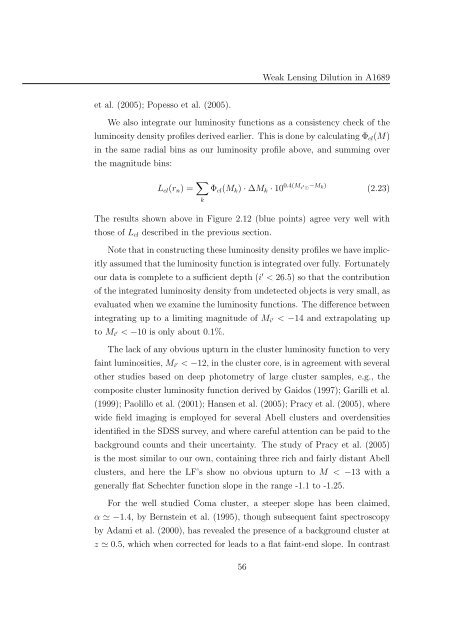Mass and Light distributions in Clusters of Galaxies - Henry A ...
Mass and Light distributions in Clusters of Galaxies - Henry A ...
Mass and Light distributions in Clusters of Galaxies - Henry A ...
You also want an ePaper? Increase the reach of your titles
YUMPU automatically turns print PDFs into web optimized ePapers that Google loves.
Weak Lens<strong>in</strong>g Dilution <strong>in</strong> A1689<br />
et al. (2005); Popesso et al. (2005).<br />
We also <strong>in</strong>tegrate our lum<strong>in</strong>osity functions as a consistency check <strong>of</strong> the<br />
lum<strong>in</strong>osity density pr<strong>of</strong>iles derived earlier. This is done by calculat<strong>in</strong>g Φ cl (M)<br />
<strong>in</strong> the same radial b<strong>in</strong>s as our lum<strong>in</strong>osity pr<strong>of</strong>ile above, <strong>and</strong> summ<strong>in</strong>g over<br />
the magnitude b<strong>in</strong>s:<br />
L cl (r n ) = ∑ k<br />
Φ cl (M k ) · ∆M k · 10 0.4(M i ′ ⊙ −M k)<br />
(2.23)<br />
The results shown above <strong>in</strong> Figure 2.12 (blue po<strong>in</strong>ts) agree very well with<br />
those <strong>of</strong> L cl described <strong>in</strong> the previous section.<br />
Note that <strong>in</strong> construct<strong>in</strong>g these lum<strong>in</strong>osity density pr<strong>of</strong>iles we have implicitly<br />
assumed that the lum<strong>in</strong>osity function is <strong>in</strong>tegrated over fully. Fortunately<br />
our data is complete to a sufficient depth (i ′ < 26.5) so that the contribution<br />
<strong>of</strong> the <strong>in</strong>tegrated lum<strong>in</strong>osity density from undetected objects is very small, as<br />
evaluated when we exam<strong>in</strong>e the lum<strong>in</strong>osity functions. The difference between<br />
<strong>in</strong>tegrat<strong>in</strong>g up to a limit<strong>in</strong>g magnitude <strong>of</strong> M i ′ < −14 <strong>and</strong> extrapolat<strong>in</strong>g up<br />
to M i ′ < −10 is only about 0.1%.<br />
The lack <strong>of</strong> any obvious upturn <strong>in</strong> the cluster lum<strong>in</strong>osity function to very<br />
fa<strong>in</strong>t lum<strong>in</strong>osities, M i ′ < −12, <strong>in</strong> the cluster core, is <strong>in</strong> agreement with several<br />
other studies based on deep photometry <strong>of</strong> large cluster samples, e.g., the<br />
composite cluster lum<strong>in</strong>osity function derived by Gaidos (1997); Garilli et al.<br />
(1999); Paolillo et al. (2001); Hansen et al. (2005); Pracy et al. (2005), where<br />
wide field imag<strong>in</strong>g is employed for several Abell clusters <strong>and</strong> overdensities<br />
identified <strong>in</strong> the SDSS survey, <strong>and</strong> where careful attention can be paid to the<br />
background counts <strong>and</strong> their uncerta<strong>in</strong>ty. The study <strong>of</strong> Pracy et al. (2005)<br />
is the most similar to our own, conta<strong>in</strong><strong>in</strong>g three rich <strong>and</strong> fairly distant Abell<br />
clusters, <strong>and</strong> here the LF’s show no obvious upturn to M < −13 with a<br />
generally flat Schechter function slope <strong>in</strong> the range -1.1 to -1.25.<br />
For the well studied Coma cluster, a steeper slope has been claimed,<br />
α ≃ −1.4, by Bernste<strong>in</strong> et al. (1995), though subsequent fa<strong>in</strong>t spectroscopy<br />
by Adami et al. (2000), has revealed the presence <strong>of</strong> a background cluster at<br />
z ≃ 0.5, which when corrected for leads to a flat fa<strong>in</strong>t-end slope. In contrast<br />
56
















